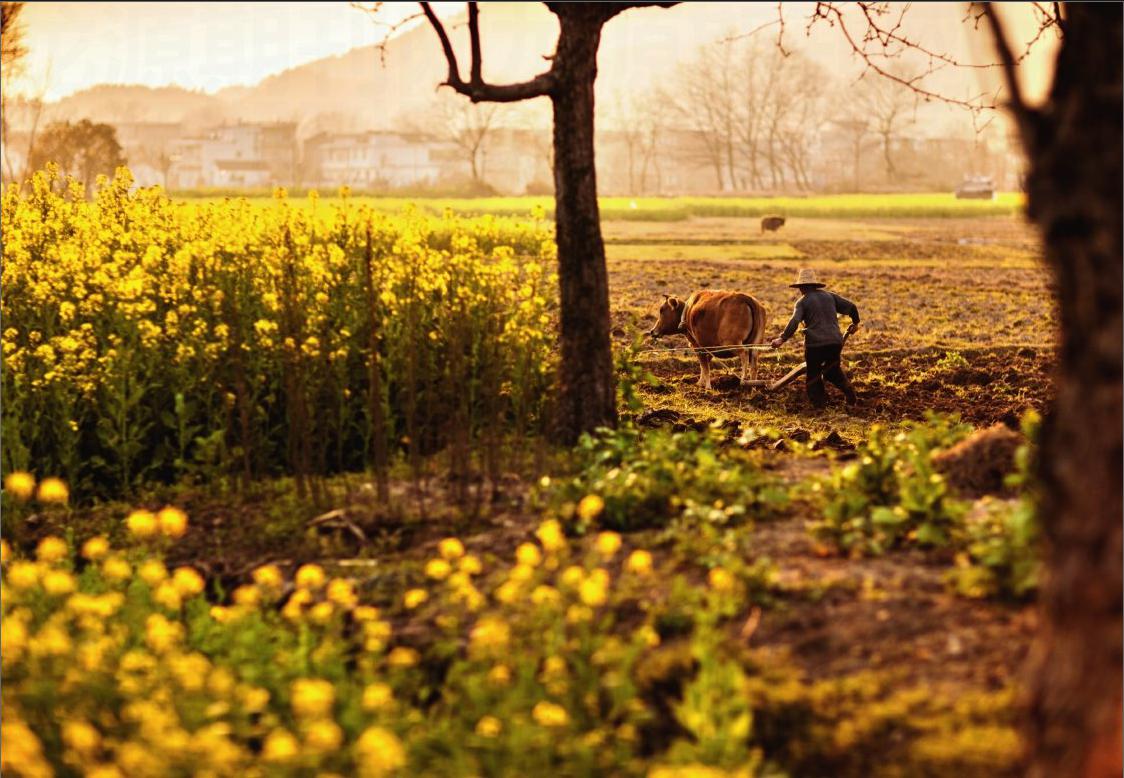Fairy Mountain Nostalgia
2015-07-09ByLISHUANGXI
By+LI+SHUANGXI


NESTLED in a valley, Kaiyuan Village is in Ruichang City in north Jiangxi Province. With a river to its south and a road to its north, this tranquil, peaceful villages lush green surroundings of paddy fields east and west present a picturesque landscape all year round.
Some 300 years ago, the village was still an isolated wilderness. The valley first became a human settlement when escapees from northern war chaos took refuge there. My exhausted ancestors stumbled upon this enclosed utopian garden after trudging for days. Having rested long enough to soothe their ragged nerves, they decided to live there. Those diligent pioneers concealed their identity and worked from dawn to dusk to build in the valley what became my beloved hometown.
Blooming Rape
Every March, the valley is festooned with golden blooms from slopes to plains and from fields to brooks.
The end of winter and the beginning of spring is the fallow period for rice plantation when farmers cultivate large quantities of rape. The seeds are sown early in the year before Spring Festival. From late February to early March, when the weather gets warmer, they rapidly flourish and seem almost overnight to gild the green valley.
Anyone traveling south by train from frigid northern China during this season experiences joy at having escaped. While the North China Plain is still suffused in a haze, the banks of the Yangtze River are already carpeted in boundless golden blooms. Weary from a solitary night journey, the sight through the train window of golden spring lifts the travelers heart and spirits.
Rape flowers in the Kaiyuan Village valley display an infinite variety of shapes. Plants in the pasture at the valley entrance grow in all directions, sometimes hanging from hillsides and ridges. It is only upon arriving at the village that you wade through the sea of flowers that flows over plains and hills.
People often compare Kaiyuan Village with Wuyuan, a tourist attraction in the same province that shares similar geographical features. However, our village does not feature the typical Hui architecture of white walls and black tiles. It is impressive instead for its simplicity and tranquility.
Butterflies and bees dart and hover over the fields at spring time, and local residents labor while children play hide and seek in fields bedecked with flowers. Some children roll up their trouser legs and catch fish and shrimps or pick water fennel from the river. When tired of this, they just lie in the golden fields and gaze at the clear blue sky, breath-ing the fresh, fragrant air.endprint
Late March to early April is the peak season for these glorious blossoms. On Tomb-sweeping Day in early April, spring rain often scatters the field borders with petals. This is when people return to their homes to mourn and pay respect to their ancestors. To children, visiting their forefathers graves is not a sad occasion. They happily follow the rituals, under their parents instruction, of burning paper money, lighting candles and incense to pray, setting off firecrackers, and kowtowing in obeisance. They are then permitted to enjoy their leisure time in the woods, where they find treasures like huge mush- rooms, yellow azalea bushes, and tasty chapao.
Kaiyuan Village is currently undergoing changes. Houses are constantly refurbished, and young people often leave to find work in cities, but generally return. I will nevertheless always cherish the memory of profusions of golden flowers when I think of my old home.
Fairy Terraces
Local inhabitants call the mountain ranges south of the village “Threshold Mountains,” because they stand south of the village like a folding screen, and present a panorama each time anyone opens their front door. Unlike other magnificent mountains, the 400-meter-high Threshold Mountains are resplendent in terraced fields and lush, jade-green orchards. Swirling mists at the mountain summit add mystery to this enchanting scenery.
The Threshold Mountains, in addition to providing a picturesque landscape, also have mystical origins. The high stone platform known as the Fairy Terrace is the backdrop to a legend.
As a little boy I first heard the story on a moonlit summer night, while lying on a bamboo bed as my grandmother fanned me with a palm-leaf fan. She said, “Long, long ago, an immortal living in seclusion was meditating and finally achieved enlightenment. She took three steps and rose up in the air, leaving the indent on the terrace of where she had been sitting and three footprints.”
Back in the age without the Internet, television or story books, we would happily elaborate on such a fairy tale. As I gradually grew and had the chance to see the terrace for myself, however, I gradually lost interest in the story and in adding mystery to it. But I did make some discoveries. To the east of Fairy Terrace was another small village and tea garden. When we finished picking tea leaves, I and friends would climb the mountain and eat lunch on the terrace. Those days stand out as the best time of my childhood.endprint
The Fairy Terrace is in the shape of a three-tier, irregular circle. The first layer is wide, consisting of soil and stones overgrown with weeds and wild flowers. The second limestone layer is tall, forming a cliff difficult for children to climb. The top tier is a narrow platform, inclining from east to west. It bears hip-like indentations to the west and three foot-like imprints, which immediately brought to mind the legend.
Most such tales have temporal origins. Beneath the Fairy Terrace is a natural cave named “Immortal Grotto.” Senior residents say that the cave was once dozens of meters deep, and that its walls were carved with Buddhist scriptures. Nowadays, the cave is frequently inundated with subsurface streams, so no-one dares to explore it. Its recesses are consequently clothed in mystery. Deep in the bamboo groves close to the cave are ancient temple ruins. This might explain the ethereal ethos of this peaceful mountain scenery.
Treasure Hunts
Spring brings not just greenery but also treasures to this mountainside village.
Those that linger in my memory are mountain flowers and wild fruits. During my childhood, nobody dreamed of sweets or candy, other than the sugar crystals we occasionally stole from my grandmother. But we made fabulous discoveries on the mountains of tasty chapao, azaleas, bamboo shoots, wisterias, raspberries, wild persimmons, wild kiwifruits, Thorny Elaeagnus fruits, and Chinese hawthorns.
The chapao is a variant of the Camellia oleifera fruit. Mostly light green or gray, it is like a hollow peach with a translucent orange-style peel. Although of a strange shape, it has a sweet taste and a fresh smell. The Camellia oleifera is an odd tree, not only because of its variant fruits, but because of its thick leaves whose color changes from green to gray. We called them tea ears, and they have a flavor similar to chapao but less juicy.
Raspberries are my favorite wild fruit. They are like small strawberries, and grow on thorny vines. Villagers call these small fruit globules “bubbles.”Since the raspberries ripen at the same time as wheat, people also call them “wheat bubbles.”
Hanging from vines, people often pick and savor these sour-sweet fruits that smell like grass. Even though modern life has brought chocolate and yogurt to rural children, they still cannot resist the allure of wheat bubbles. My mother never forgot to pack them in a handkerchief and carry them home on cow horns. My father would also bring back ripe fruits after chopping firewood or tending the fields, in the same way as urban residents bring back gifts of food for children when they have been away on business.
Ripe wheat bubbles signify the passing of spring. Wild fruits still hide deep in the mountains ready to slake the thrist of any travelers that discover them.endprint
